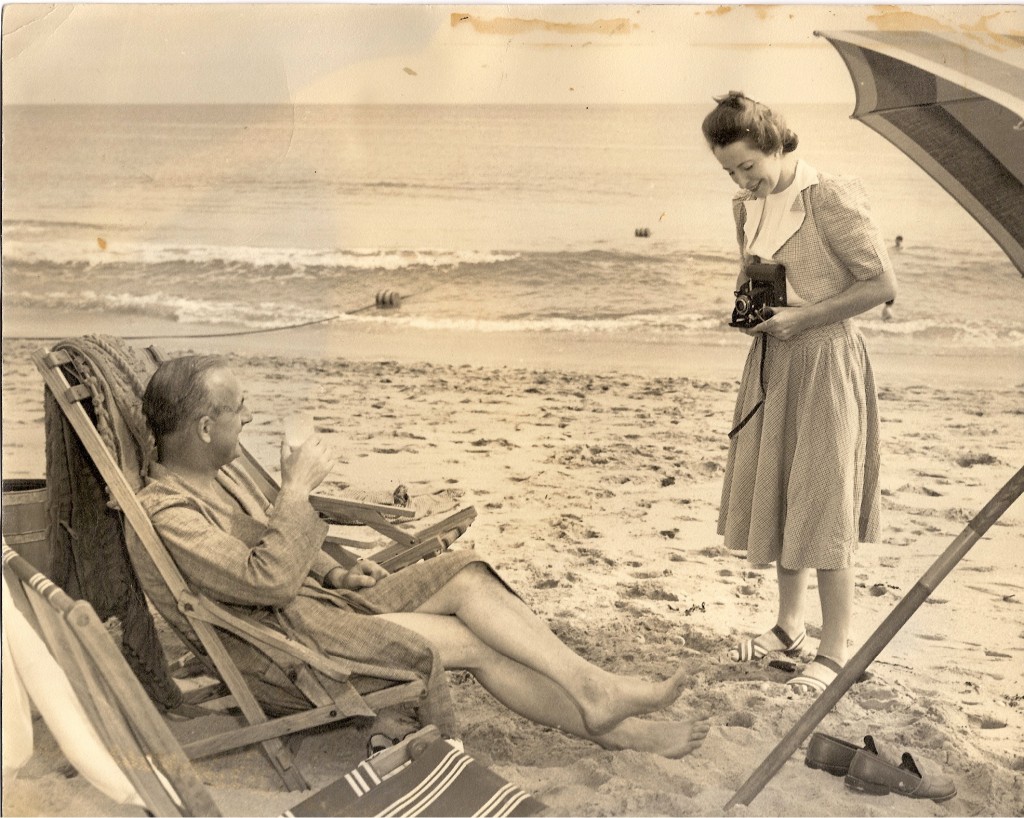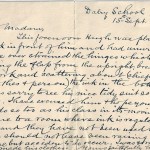 This is, without question, one of the greatest family pictures of all time. I never got to meet my grandfather, Hugh Simmers, Jr. He died when my mother was 16. But I’m sure I would have really enjoyed his company. In addition to having a penchant for photography, he must have had a good sense of humor. And he certainly knew the importance of having a great time.
This is, without question, one of the greatest family pictures of all time. I never got to meet my grandfather, Hugh Simmers, Jr. He died when my mother was 16. But I’m sure I would have really enjoyed his company. In addition to having a penchant for photography, he must have had a good sense of humor. And he certainly knew the importance of having a great time.
I’ve often imagined how it went on the set of this photo shoot. Simmers (1895-1949), who operated cameras in Scottish silent movie theaters as a young man, probably put a chair down on Ft. Lauderdale beach in Florida, where the family was vacationing. He must have asked his wife, Mabel, who could be a good sport, and was eight years his junior, to hold a camera nearby.
Then he probably set another camera on a tripod and checked to make sure he could get the whole scene in a frame. After that, he probably put the camera on time lapse and rushed to take his place in the chair before the shutter clicked.
Or else he just asked his brother William to take the picture. It was shot on Christmas Day in 1940.
Simmers left behind an impressive collection of family photos, including innumerable shots of my mother. For the longest time, she kept his ancient equipment in our front hall closet in St. Louis. Now I wish I had it.
The five-foot-seven, 150-pound Simmers emigrated from Scotland in 1919 at the age of 24, entering at Ellis Island. He left his native land after his parents had died. He was the youngest of eight children to Hugh Simmers (1850-1916) and Marion Murray (1859-1917). His eyes were brown and so was his hair, at least in the early years.
In the Scottish tradition, Simmers was not only an accomplished businessman–he owned a distributorship, County Refrigeration, in Mount Vernon, N.Y.–but a musician as well. Growing up, we would find his various instruments, including a red accordion, in my grand mother’s closets, even though he had passed more than 10 years before. I don’t remember finding any kilts or bagpipes, though.

Simmers played the piano by ear. My mother used to say that she’d come home from school humming a popular tune. The next time she hummed it, her father would play it on the piano. It irritated her that he could pick up a tune so quickly, when she would struggle with the sheet music.
When my mother was young, the family often spent winters in Florida, where the photo above was shot. This was an ordeal for the children, who would have to suspend her studies in New York and pick them up at a different school in Florida. Meanwhile, photographic evidence indicates that my grandfather would go sport fishing, play golf, or shoot pictures by the sea. The family managed to find time to visit all the local seaside attractions.
It’s possible to stitch together a portrait of Simmers’ early life in Scotland, through the wallets, official papers, and memorabilia he left behind, coupled with a search of public documents online.
His father, Hugh, Sr., for instance, is listed in the 1881 Scottish Census as a comb maker, a job he held for at least 20 years. He has the same occupation in the 1891 Scottish Census. The 1901 Census provides just a little more detail, but that detail turns out to be critical. His occupation is listed as a foreman in a vulcanite factory. Vulcanite is a rubber used to make combs.
Hugh, Sr., probably worked for the Scottish Vulcanite Company, a big manufacturer of combs during that time. The company was renown for its efficient production. According to Cassell’s Old and New Edinburgh, the steam cutters there were so expert, “rising and falling with rapidity, and fed by skilled workmen,” that the factory managed to produce a hundred dozen combs each day. The combs were used for combing wool, not human hair. The work must have been hard.
Amazingly, a Google Maps search reveals the stone apartment buildings where the family probably lived. In 1891, the family resided at 4 Fowler Terrace in Edinburgh, which is only 2 miles outside the city center. They move moved a couple blocks away to 31 Dundee Terrace , a somewhat nicer address, before the 1901 Scottish Census. I wish I had known this when I visited Edinburgh several years ago.

We know from a letter Simmers left behind that in 1903, at the age of 8, he attended the Dalry School, which was only two blocks from his home. Established in about 1876, it still operates in the West of Edinburgh as a non-denominational primary school.
The letter was from a teacher explaining why Hugh had come home one day with ink on his clothes. It lays out the accident in vivid detail, saying that Hugh had been “playing” with a desk in front of him. The desk gave way after he strained its hinges, spilling ink all over his suit. It’s worth reading in its entirety.
The industrious Simmers held a job as early as 15; my mother thought this explained his wanderlust in later years. From the summer of 1910 until January 1914, he worked at the Foundry Department of the Carron Company, now known as Carron Phoenix. The company, which began as an iron foundry, says it was a major driver of the Scottish industrial revolution.
Simmers later held several jobs as an electrician and operator at movie theaters. He left behind membership and dues cards that indicate he belonged to the Edinburgh Cinema Operators branch of the Electrical Trades Union.
From November 1915 through April 1916, Simmers was the chief operator at the Edinburgh Elm Row Palace theater. Then, from the spring of 1916 until October 1917, he served as chief electrician and operator at the King’s Cinema at 38 Home Street in Edinburgh. This may have been a step up.
Amazingly, the King’s Cinema, which opened in January 1914, is still in operation, though it goes by the name Cameo now. The landmark theater originally sat 673 people on a single level, sloping down toward a mirrored screen that was a first in Scotland. The silent films it showed were accompanied by a live orchestra. Click here to see what the projector room, where Simmers may have worked, looks like today.
The gaiety ended for Simmers when he enlisted on Oct. 14, 1917 in the Royal Artillery. My mother used to say he was part of the Royal Horse Artillery, and we have photographic evidence of this. The RHA was in charge of light, mobile guns that supported the cavalry.
The RHA was in charge of light, mobile guns that supported the cavalry.
He transferred at some point to the Royal Army Ordance Corps. A special emergency card lists him as part of the 21st East Anglican (Essex) Heavy Battery RGA. It looks like he never left the country during his tour of duty. At least that’s what his Certificate of Transfer to Reserve indicates.
After the war, Simmers came to New York City with his sister, Christina, to reunite with a brother and sister who had already moved there. The pair lived with their older sister, Jessie, and brother-in-law, Wilborn Lynch, in a Manhattan apartment, according to the 1920 U.S. Census. Another older brother, William Simmers, also lived there. The apartment was located at 207 West 80th Street, three blocks from Central Park. It was probably a pretty nice address at the time.
Hugh, Jr., worked as a tire salesman. He was probably employed by his brother in law, Lynch, who was an auto merchant. His sister Chris, who is listed in the census as an automobile clerk, probably worked at the same firm. Older brother William Simmers was a private chauffeur at the time. He ultimately did very well for himself, leaving behind a New Jersey estate.

Simmers married Mabel McCullen, who was from a large Irish family, on June 4th, 1927, eight years after he had entered the country. His older brother William was his best man, judging by the wedding picture on the left. Simmers became a naturalized citizen five months later.
According to the certificate, the couple was living at 2137 Haight Avenue in the Bronx at the time. They were still living in the Bronx three years later, when Hugh was employed as a service manager for Frigidaire. We know this because in October of that year, he received a bonus check from Frigidaire, along with a nice note from President Winston Paul, which he proudly left behind.
The couple took their time to have children. They ultimately had two. My mother, Marie Patricia, was born in 1932, and Hugh, Esq., was born two years later. At some point the family moved to Westchester County. They lived at 5 Moreland St. in Yonkers, a nice address, throughout the 1940s.
Simmers may have adopted the United States as his home, but he still ate like he lived in the old country. Hugh, Esq., remembers that his father would insist on meat and potatoes along with a dessert every night. Holiday celebrations would call for a standing rib roast and Yorkshire pudding or a leg of lamb. Being in the refrigeration business, calling on food wholesalers and grocers, Simmers knew people with access to prime cuts.
At some point, probably after the family moved to Yonkers, Simmers established his own business, County Refrigeration Service, Inc., in Mount Vernon, selling and servicing Frigidaire units. He was active in civic associations throughout his time in the United States. He joined the Masons shortly after arriving in the country. In 1940, he served as president of the Mount Vernon Rotary Club. He was a Shriner as well.
Hugh died tragically in 1949, at only 54 years of age, before any of his grandchildren would know him. Fortunately, based on the many notebooks of travel photos he left behind, he lived a full life. Interestingly, his services were held at a Masonic temple. More on that later.
This is great stuff, Boyce. Aunt Mabel would be thrilled! I have to smile at the roast beef and Yorkshire pudding, as Nana and Pop were big on it too, and I grew up eating it and still make it for Christmas dinner.
Cousin Judy
I remember mrs Simmers and Hughie was a good friend of mine. When did Hughie die?
Auntie Mabel would bring my sister and me the most beautiful dresses every Easter and Christmas. She had such lovely taste. My Dad was William Brown. Thank you for such wonderful memories.
Hello~ I came across this page as I was researching an identification bracelet which I recently purchased at an auction here in Vermont. I believe it belonged to your grandfather, Hugh Simmers. I was just about to list it on an Ebay auction but, having dabbled off & on for years on my own ancestry, I was interested to look up the name on the bracelet. If you would like to communicate with me about this, please email me~
Sincerely, Anne